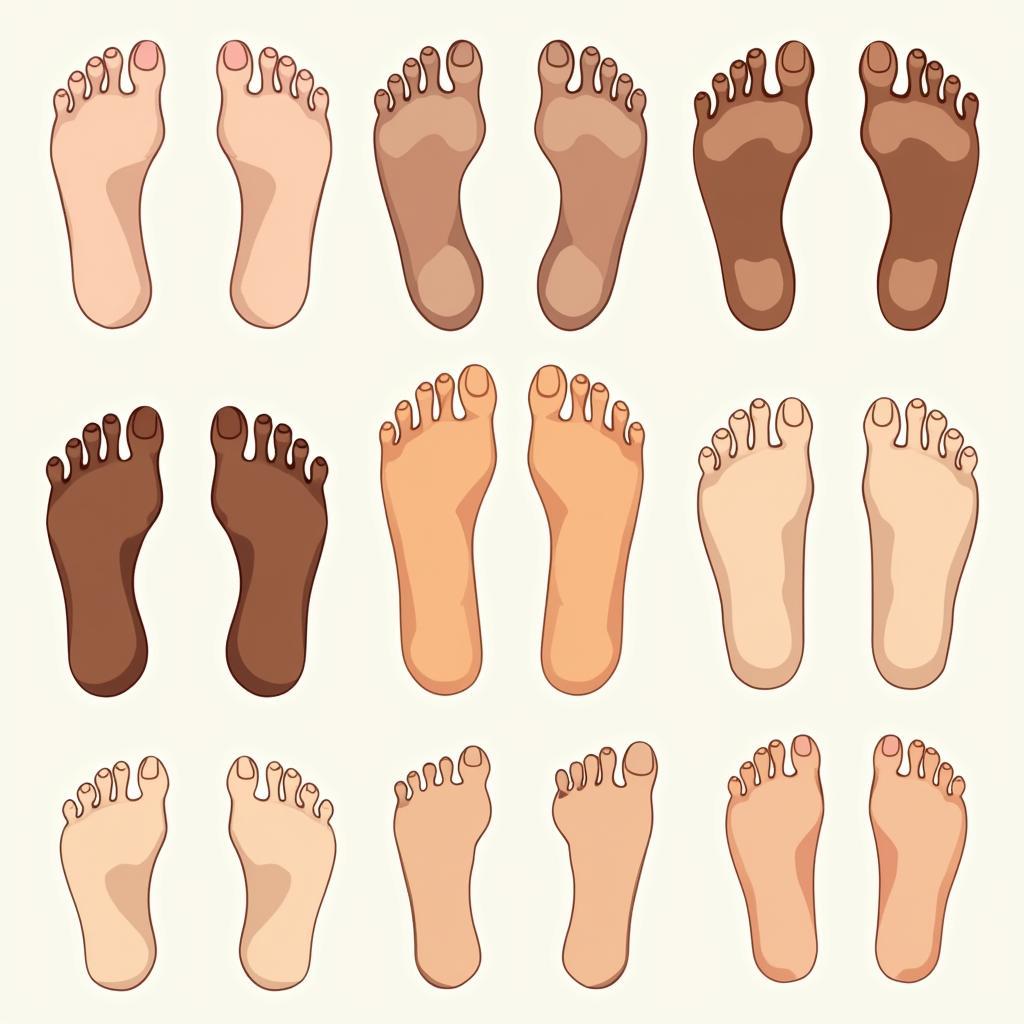Uncovering the Truth About the African Foot Shape
The human foot, a complex structure of bones, muscles, and ligaments, varies considerably across the globe. Recent discussions about the “African Foot Shape” have sparked curiosity and raised questions about its unique characteristics. Is there truly a distinctive African foot shape? Let’s delve into this fascinating topic and explore the scientific evidence, cultural influences, and potential implications for health and footwear.
The notion of a singular “African foot shape” is an oversimplification. Just as diverse cultures and ethnicities exist across the vast continent of Africa, so too does foot morphology. While it’s tempting to categorize, the reality is far more nuanced. However, some common trends have been observed in certain populations. We’ll examine these observations, but it’s crucial to remember that these are not universally applicable to all Africans. One popular misconception needs to be addressed early on: the idea that all Africans have wide feet. This simply isn’t true. Foot width, like other aspects of foot morphology, varies significantly across the continent.
Exploring Variations in African Foot Morphology
Several factors contribute to foot shape variations within African populations, including genetics, lifestyle, and environmental influences. Some studies have suggested a correlation between certain genetic markers and foot morphology in specific ethnic groups. For example, some West African populations exhibit a lower arch compared to other groups. Similarly, individuals from East African pastoralist communities, who often walk barefoot on uneven terrain, may develop stronger foot muscles and a wider forefoot.
What about the influence of footwear? While many rural communities in Africa traditionally go barefoot, the increasing adoption of Western-style footwear, particularly in urban areas, might impact foot development over time. This shift could lead to changes in foot shape and potentially increase the prevalence of certain foot conditions. Let’s analyze the impact further. Have you ever wondered about the connection between foot health and the African Champions League draw? Perhaps not directly, but the physical demands of professional football highlight the importance of proper foot care for athletes across the continent.
 African Foot Variations: Exploring Diverse Morphologies
African Foot Variations: Exploring Diverse Morphologies
The Impact of Footwear on Foot Health in Africa
The transition from barefoot walking to wearing shoes can have both positive and negative effects on foot health. While shoes offer protection against injuries and infections, ill-fitting footwear can lead to problems like bunions, hammertoes, and ingrown toenails. This is particularly relevant in rapidly growing urban areas, where access to properly fitted shoes might be limited. Furthermore, certain traditional footwear practices, such as tightly bound feet, can also have detrimental effects on foot development and health.
Is there a perfect shoe for the “African foot”? Again, this question oversimplifies a complex issue. The ideal footwear choice depends on individual foot shape, activity level, and personal preference. Promoting awareness of proper foot care, including choosing appropriate footwear, is crucial for maintaining foot health across diverse African populations. Speaking of African achievements, did you know about the African famous people facts? Their stories are a testament to the continent’s rich human capital.
Debunking Myths and Misconceptions
It’s crucial to dispel the myth of a single “African foot shape.” The reality is that foot morphology in Africa, like everywhere else in the world, is highly variable. Generalizing can lead to misunderstandings and hinder efforts to address specific foot health needs within diverse communities. Promoting research focused on understanding the nuanced variations in African foot morphology is essential for developing culturally sensitive and effective foot health interventions.
Dr. Fatima Mtwara, a leading podiatrist in Tanzania, emphasizes the importance of individualized care: “Each foot is unique, regardless of geographical origin. We need to move away from generalizations and focus on providing personalized assessments and treatment based on individual needs.” Another expert, Professor Adebayo Olufemi, a biomechanics researcher in Nigeria, adds: “Understanding the interplay between genetics, lifestyle, and footwear is crucial for promoting optimal foot health in Africa.”
The 2018/19 South African Premier Division showcases the athletic prowess of African footballers, reminding us of the importance of healthy feet for optimal performance. Similarly, the African Cup of Nations results highlight the diverse talents across the continent.
Conclusion
While the concept of a singular “African foot shape” is a myth, the diversity of foot morphologies across the continent is undeniable. Understanding this diversity is essential for promoting foot health and developing appropriate footwear solutions. Further research and culturally sensitive approaches are needed to address the specific foot health needs of diverse African populations.
FAQ
- Is there a single African foot shape? No, foot shapes vary greatly across Africa.
- What factors influence foot shape? Genetics, lifestyle, and footwear.
- Why is understanding foot variation important? For proper footwear and foot health.
- Are wide feet common in Africa? Not universally, it varies by region and ethnicity.
- How does footwear impact foot health? Can be positive or negative depending on the fit.
- What are some common foot problems? Bunions, hammertoe, ingrown toenails.
- How can I ensure good foot health? Wear properly fitted shoes, regular checkups.
You might also be interested in learning about the African elephant skeleton, showcasing the incredible biological diversity of the continent.
Need support? Contact us 24/7: Phone: +255768904061, Email: kaka.mag@gmail.com, or visit us at Mbarali DC Mawindi, Kangaga, Tanzania.